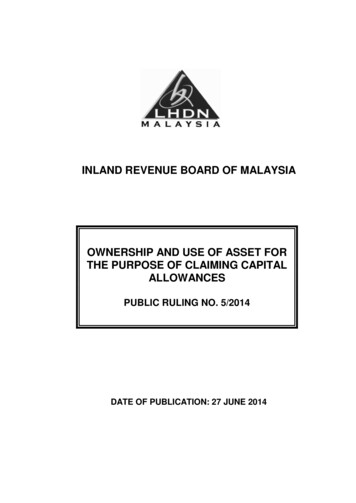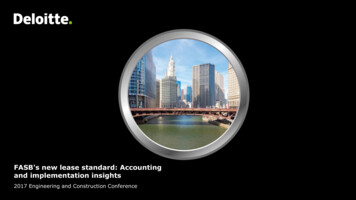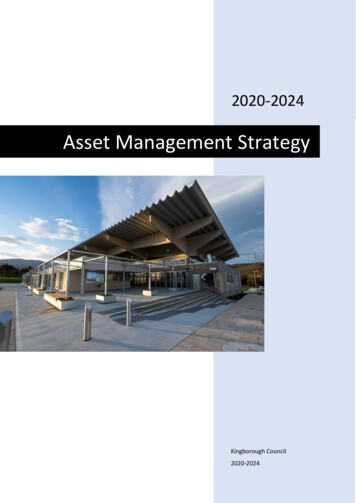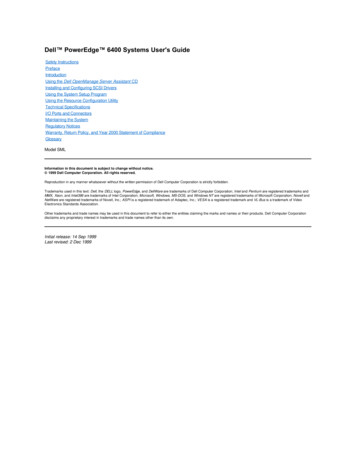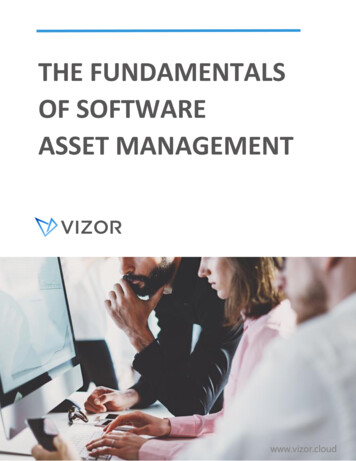
Transcription
THE FUNDAMENTALSOF SOFTWAREASSET MANAGEMENTwww.vizor.cloud
THE FUNDAMENTALS OF SOFTWARE ASSET MANAGEMENTTable of ContentsDefining A Software Asset1Defining Software Asset Management2Why Is SAM Important?Benefits of Software Asset Management3Improved IT AssetsMaintaining an Effective License PositionOrganizational BenefitsReduced IT Costs4Essential Sam Processes5Tracking LicensesCost of LicensesLicense ComplianceReporting6Software Lifecycle ManagementAdditional Benefits of a SAM Tool9Easily Transition from SpreadsheetsDocumentation ManagementProactive Email Reminders/AlertsWorking with Other Departments10Working with ProcurementWorking with Human ResourcesWorking with FinanceBest SAM Practices11Track Software LicensesContinuously Monitor ExpenditureManage DocumentsImplement SAM for Improved Business StrategyGuide: Determine Ideal SAM Strategy13Glossary (italicized terms found here)16www.vizor.cloud
Defining A Software AssetAsoftware asset is any software used by anorganization to assist/accomplish the businessfunction. Organizations invest in software toimprove their current processes. As a result, theyare considered software assets. This can becompared to software that does not affect theirbottom line. For example, a business maydesignate acquiring Microsoft Office 365 as aninvestment whereas software like GoogleChrome, although important to an organization,may not be considered to be investment.In order to use and distribute most software,organizations must purchase software licenses.Software licenses are legal entitlements andobligations for using software. They can bebought as a perpetual license or a subscription.A perpetual software license agreement ispurchased for a one-time fee with optionalrecurring maintenance costs. However, asubscription license is encouraging organizationsto invest in software subscription models thatare generally paid on a monthly or yearly basisand are usually accessible through the cloud.Cloud computing is basically a number of remoteservers and networks that allow organisations toaccess services, software and storage via an externalplatform - ITAM ReviewA perpetual software license is a type of softwarelicense that authorizes an individual to usea program indefinitely. Generally, outside oftermination, a perpetual software license allows theholder to use a specific version of a given softwareprogram continually with payment of a single fee.-Whatis.comAlthough software assets are often overlookedfrom an organizational perspective, theirintangible form should not discourage propermanagement. More and more organizations areseeing the value of including software assetmanagement in their business strategy.Let’s take a closer look at Software AssetManagement.The Fundamentals of Software Asset Management 1
Defining Software Asset ManagementIndustry leaders define Software AssetManagement:“Software Asset Management (SAM) is all of theinfrastructure and processes necessary for theeffective management, control, and protection ofthe software assets within an organizationthroughout all stages of their lifecycle.”– ITAM Review“Software Asset Management (SAM) is a set ofproven IT practices that unite people, processes,and technology to control and optimize the use ofsoftware across an organization. SAM can helpyou control costs as well as manage business andlegal risks, optimize software licensinginvestments, and align your IT investments withbusiness needs.”– Microsoft“Software Asset Management (SAM) is the ongoing process of overseeing the lifecycle of thesoftware applications in your organization. SAMoptimizes IT practices by streamlining workflows,stabilizing the IT budget, and maintaining controlover the organization’s software license position,at all times”- VizorThe definitions summarize similar points whilethey each reveal fundamental parts of SAM.ITAM Review points out the importance ofprocesses for effective software assetmanagement, throughout their lifecycle.Microsoft explains the importance of theintegration of these processes with thetechnology and employees to further benefit theorganization. And Vizor highlights how SAM isan on-going process and will consistently benefitthe organization with the right practices in place.WHY IS SAM IMPORTANT?If the benefits of Software Asset Managementare not yet clear, consider how organizationsspend approximately 21% of their IT budget onsoftware.¹ Without a proper SAM solution, that is21% of the IT budget simply being ignored.Imagine disregarding one fifth of your income,or one fifth of your employees. That’s a lot!The software market in the US alone accountsfor billions of dollars. As the market grows, moreand more businesses are realizing the value ofmanaging software assets. Taking advantage of aSAM strategy can help organizations in countlessways, placing them ahead of their competitors.For example, streamlining IT processes allowsorganizations to provide a quicker, moreconsistent service, ensuring employees remainproductive.There you have it- an edge over the competition.The Fundamentals of Software Asset Management 2
Benefits of Software Asset Management"Information Technology and business arebecoming inextricably interwoven. I don't thinkanybody can talk meaningfully about onewithout the talking about the other" - Bill GatesAs discussed, Software Asset Management isthe management and optimization of softwareasset processes that are aligned with theemployees’ and organization’s goals. But whatare some direct benefits of implementing a SAMstrategy?1. IMPROVED IT PRACTICESSoftware Asset Management encouragesorganizations to implement procedures andpolicies that they may have overlooked. This getsemployees involved in the processes,establishing better communication between ITand the users.In addition, it encourages the monitoring of allrelevant software information. By having allsoftware information in one area, IT has bettercontrol, management capabilities and improvedinsight on software statistics. This makes it easierto retrieve pertinent data and shadow IT. ShadowIT refers to when employees sign up forsoftware, like online cloud services, on their own,without the knowledge of IT. Therefore, SAMgives IT control over the assets they’reresponsible for and reducing departmental silos.A modern SAM tool can streamline processes,saving the IT department from doingunnecessary manual and repetitive labor andultimately saving time. IT can focus on strategyand delivering a good service.2. MAINTAINING AN EFFECTIVE LICENSEPOSITIONUnder “Defining Software Assets”, softwarelicenses were discussed as part of anorganization’s legal entitlement and obligationsfor using software. A key activity provided by aSAM tool is the comparison of softwareinstallations with purchased licenses. Thiscomparison is known as the Effective LicensePosition, and tells us whether we are under-orover-licensed, indicating if adjustments areneeded to achieve an optimum Effective LicensePosition (ELP).Demonstrating that it continually monitors itsELP is particularly important for organizations topass – potentially even avoid - vendor audits,which will be discussed in more detail later.The implementation of a modern SAM tool canautomatically compare software licenses andinstallations. This informs IT of their ELP at anytime they need it with almost no manual labor.3. ORGANIZATIONAL BENEFITSA SAM strategy affects an entire organization bymaintaining productivity, introducing improvedIT procedures and increasing reliability in IT. ASAM solution can even benefit specificdepartments, which will be discussed later. Inaddition, if a SAM solution is properlyimplemented an organization can benefit fromreduced IT cost.The Fundamentals of Software Asset Management 3
4. REDUCED IT COSTSBy properly implementing SAM, organizationscan benefit from improved IT practices,maintaining an ELP, and reduced IT costs.In many cases, IT departments over-purchasesoftware because they are not aware of thesoftware they already own or its usage. However,SAM provides detailed insight into theorganization’s applications from which IT costreductions can be identified.Here is some information SAM can collect: What software the organization owns Quantity of software licenses What software is installed Who is using the softwareThis information contributes to a SAM conceptcalled software asset optimization.Software asset optimization is a proactiveapproach to ensuring your organization hasthe optimal number of licenses- meaning thatthe organization reduces the number of ownedlicenses when they are not needed or being usedby employees. It compares the softwareneeded (type of applications, quantity required)to license ownership (which licenses youpurchased, quantity installed). As a result, anyexcess software will be identified. Theorganization can then take the appropriate stepsto reduce their unused licenses and ultimatelyreduce their costs.Examples of the techniques to obtain softwareoptimization: Remove allocated software licenses thatare not required for that user, as part ofde-provisioning processes discussed ingreater detail later Investigate software metering/usage:determine what software is being usedand either retire it or store in a “pool” ofunused licenses Practice software recycling: retrievesoftware from a pool of licenses andreallocate it to users who need itSAM empowers the IT department to makesmart purchasing decisions and prevents overexpenditure in the future.The Fundamentals of Software Asset Management 4
Essential SAM ProcessesSoftware Asset Management processes maybe beneficial to your organization in severalways. Examples of processes include Tracking LicensesMinimizing the cost of LicensesMaintaining License ComplianceReportingSoftware Asset Lifecycle Managementpurchased as well as managing supplierinformation. A proactive SAM solution can alsonotify you of any changes to your assets bysending email notifications. Overall, a SAM toolhelps organizations stay on top of theirpurchases, remain within their budget and meetan Effective License Position.COST OF LICENSESTRACKING LICENSESFor many organizations, spreadsheets are usedto track software licenses and their associateddetails. Listing software licenses helpsorganizations monitor what software they ownand who is using them. To be effective, thesespreadsheets require constant management.The maintenance of a spreadsheet requiresfrequent updating and cross referencing with anetwork/inventory tool such as Microsoft SCCM.However, modern SAM tools can be used tomanage on-premise PC software licenses, mobileapp purchases and cloud service subscriptions,without the hassle of constant supervision ormanual updates. They can track the number oflicenses in use and the type of licenses you haveSoftware is typically bought as a perpetuallicense with yearly maintenance costs or as asubscription. Currently, most businesses have acombination of both.Consequently, keeping track of costs can get outof control.It is important to manage all softwareexpenditure, no matter how it was purchased.Regardless of how small a monthly subscriptionmay be, all purchases should be monitored andmanaged.SAM solutions keep track of purchases, monthlycosts, and maintenance fees. They are ableto break down software expenditure by month,year or by employee, department and project.Usually, SAM tools display metrics mostimportant to the organization in a dashboard,which can also be compiled into customizedreports.LICENSE COMPLIANCELicense compliance is ensuring the organizationis adequately licensed. Each vendor has differentstandards of what it means to be compliant.The Fundamentals of Software Asset Management 5
It is important to ensure you are meeting thelicense requirements by each vendor to passvendor audits. The successful implementation ofa modern SAM tool facilitates this bycontinuously tracking software licenses andinstallations in its ELP reports.As a result, the organization will be relieved ofassociated fines from audits, or a damagedreputation within the company, as well asavoiding wasted expense on unused software.have extensive reporting capabilities that willhelp analyze the metrics most important to theorganization.A SAM tool may also use a process callednormalization that creates simplified butaccurate reports, based on software installationdata. The process of normalization transformsraw installation data into actionable information.It can also create consistency in software assetdetails, such as publisher, title, version andedition.REPORTINGIt is highly recommended to produce reports ofyour software assets on a regular basis. This isimportant for your records as well as providingsoftware information requested by otherdepartments. Reports provide insight on painpoints, procedures and breakdown of costs.The time taken to create reports can be reducedwith Software Asset Management tools as theySOFTWARE LIFECYCLE MANAGEMENTOne of the most important aspects of SoftwareAsset Management is the monitoring of assetsthroughout their entire lifecycle. This includessoftware requests, software authorization,procurement, provisioning, de-provisioning, andsoftware recycling.The Fundamentals of Software Asset Management 6
Software RequestTo keep IT informed about all the software in theorganization, SAM encourages the setting up orstrengthening of procedures to eliminate the riskof shadow IT. Therefore, eliminating thepossibility of employees signing up for softwareon their own, without the knowledge of IT. Aslong as software requests go through an ITprocess, they can be made through email, overthe phone or through a request portal.To encourage a streamlined process, SAM toolsmay offer a request portal for employees to fillout their own requests. This removes manualentry as well as unnecessary steps to start therequest process. Once a request is made in theportal, the entire process is started automatically.The request portal can also be populated with asoftware catalogue, simplifying the process evenfurther. This limits employees to chose from arestricted list of software request and sets updifferent forms for each software listed.processes, even if there is a multi-layeredprocess. For example, a software request mightbe approved by an end user’s line manager first,then the system owner, and finally companydirector. Whether the request is approved orrejected, the decision is reported back to IT sothey can either continue the process or stop anypurchases.The approval processes can be facilitated with aSoftware Asset Management Tool by gettingauthorization by the right people in a timelymanner- not to delay IT.ProcurementWhen a software license is not available uponrequest, a purchase request is created. This caninclude procurement processes such as thefollowing Requisitions – Creation of a purchaseorder through the existing purchasingprogram Vendor Follow Up – Reminders to followup with vendors to confirm purchaseorders Maintaining an inventory of goods uponreceipt Financial Settlement – monitoring cost oftransactionThis is important information for IT in order toSoftware AuthorizationOrganizations may already have approvalprocesses in place. However, they do not alwaysconsider IT as part of any software-relatedprocesses. It is ideal for employees tounderstand how the approvals fit within ITinstall the software, let all employees know it isavailable, and take note of the costs andassociated maintenance fees.SAM tools can simplify the process byautomatically integrating the purchasingdepartment within the appropriate IT processes.The Fundamentals of Software Asset Management 7
ProvisioningProvisioning is the allocation and deployment ofsoftware assets to users. For example, if acompany is hiring dozens of interns, theirsoftware requirements can be prepared inadvance. The benefit is the proper managementof costs and availability of licenses. Modern SAMsolutions can automatically provision softwarebased on a user’s position or role in thecompany. As a result, new employees are ableto work as soon as they start.De-provisioningThe process of de-provisioning is the removal ofunnecessary software and the de-allocation oflicenses. It can be performed in many instances.When an employee leaves or changesdepartments, IT can de-provision the softwarethe employee had access to. This re-enters thesoftware licenses into the license pool, fromwhere they can be re-distributed to another user.Furthermore, the removal of software isbeneficial when metering data shows licenses arenot being used. As a result, licenses can also beput into the license pool, to be recycled later on.Gartner reported that recycling software cansave an organization up to 30% of IT costs withinthe first year of implementation.²It isn’t uncommon for organizations to haveprojects that may require access to softwarelicenses for the duration of the project. Whenthe project is completed or an employee leavesthe project, de-provisioning can retrieve thoselicenses. De-provisioning can be an excellentway to save money, reduce waste, leverageexisting investments, and practice softwareoptimization.Uninstalling licenses or deactivating cloudsubscriptions would normally be done manually;however, a modern SAM tool is able to deprovision with just a few clicks.Software RecyclingAs previously mentioned, it is ideal to re-usesoftware licenses. As long as the vendor permitsthe re-allocation, it is a great method to save oncosts. Although usually a manual task, a modernSAM tool can generally re-distribute themautomatically.The Fundamentals of Software Asset Management 8
Additional Benefits Of A SAM Tool"While technology is important, it's what we dowith it that truly matters" -Muhammad YunusEASILY TRANSITION FROM SPREADSHEETSOrganizations may practice Software AssetManagement with the help of spreadsheetsrather than a SAM solution. Although this is apositive start to managing your software, it lacksthe proactive approach that provides yourorganization with real-time data, streamlinedprocesses, automatic reporting, and companywide trust.Spreadsheets are prone to error, time consumingand unresponsive, whereas a SAM tool is quitethe opposite. If you started to manage yourassets in spreadsheets, a modern Software AssetManagement solution has the ability to collectthe data from them, automatically. There is noneed to re-enter data manually, eliminating thepossibility of human error. The SAM tool ensuresdata accuracy and reliability while promotingconfidence in IT practices throughout theorganization.DOCUMENTATION MANAGEMENTBusy IT managers sometimes overlook theimportance of managing the documentation forsoftware license, maintenance and subscriptionagreements, together with the related purchases.A SAM tool can facilitate license-relateddocument management with a file repository. Bystoring all necessary documents in onelocation, they are easily accessible and can belinked to the appropriate software assets.Frequently, there is even the possibility to link toan existing documentation repository such asSharePoint.Finally, having relevant documentation isimportant to support your software licenseentitlements for vendor audits. By backing uppurchases, the organization reduces the chanceof costly penalties.PROACTIVE EMAIL REMINDERS/ALERTSA SAM solution often has the capability ofsending email reminders or alerts. This isparticularly beneficial to remind IT ofmaintenance and subscription renewals.Alerts are also important for IT to better preparefor negotiating. This can lead to better contracts,remain at an Effective License Position and evenavoid renewal penalties.A SAM solution caters to an organization’sspecific needs by offering to set up customizableemail reminder alerts, on specific days, at specifictimes.The Fundamentals of Software Asset Management 9
Working with Other DepartmentsSoftware Asset Management is primarilyfocused around IT, but, requires the support andcollaborative efforts from other departments ifthe SAM platform is to perform at maximumeffectiveness to work. The following are the keydepartments IT must join forces with forsuccessful a Software Asset Managementprogram.WORKING WITH PROCUREMENTThe procurement and IT departments shouldwork together to comprehensively distributesoftware. There are several instances in SAMprocesses, as previously mentioned, that requiresthe inclusion of the procurement department.For example, an employee notifies IT of a newsoftware request. However, the process can onlybe completed with the involvement of theprocurement department. Particularly,procurement will be part of the process once asoftware request is approved, and may even bepart of the negotiation and contractual terms. Asa result, a certain relationship and trust must beestablished between departments. Evidently, amodern SAM tool will facilitate this relationshipbut it can also be done without one.WORKING WITH HRBy working with Human Relations (HR), IT is ableto set up new employees in their new positionmuch more quickly. Normally, this procedurecan take a few days to complete, but aftersetting up the appropriate documents andsoftware for each position, the process can bestreamlined. In a modern SAM solution, it canbe done with one click. New employees receivedocuments and access to software and cloudservices, automatically. This process is alsobeneficial to employees changing departments.A SAM tool removes access to previous softwareand allocates new applications relating to thenew position. Not only does working with HRsimplify the on-boarding of new employees butit also provides security measures for whenemployees leave. It isn’t uncommon forcompanies to unwillingly leave access tosoftware to former employees. By working withHR, this de-provisioning can be done efficientlyand minimizes security risks.WORKING WITH FINANCEWith Software Asset Management in place, theIT department is able to provide greater insightinto the costs of software usage and purchases.This helps the finance department keep track ofdepartmental costs.The documentation management of a SAM toolwill also provide the appropriate files the financedepartment requires for their financial audits. Asa result, SAM processes facilitate the sharing offinancial information.The Fundamentals of Software Asset Management 10
Best SAM PracticesRegardless of what you are managing, thereare practices to follow to obtain the best results.The following are the top 5 practices for aneffective Software Asset Management program,whether or not it is with a SAM tool:possible, it is better to have a general idea ofyour license position as opposed to none."Good, bad or indifferent, if you are notinvesting in new technology, you are going tobe left behind" -Philip GreenTRACK SOFTWARE LICENSESBe sure to maintain an updated list of all yourpurchased software licenses, which include bothperpetual licenses and cloud subscriptions.Ensure each application is associated to thecorrect users and is updated when there are anychanges. This will give a better idea of whichlicense you have the legal right to use. In otherwords, your license entitlement. In addition,maintain records of data related to the softwareassets. This can include contract details, time forrenewal, purchase costs, maintenance contractsand service fees. Evidently, this process can bedone automatically with a modern SAM tool,however, in the case that obtaining one is notCONTINUOUSLY MONITOR EXPENDITUREIt is essential to monitor and breakdownexpenditure to get a clear picture of theallocation of your budget. It isn’t uncommon fororganizations to inadvertently waste money onlicenses because they lack the processes tomanage the costs.It is also recommended to create reports for abetter understanding of metrics that are relevantto your goals. Use the information to comparepast and current expenditure as well as forecastfor your IT budget. Although these processes canbe done manually, it might be easier to use aSAM tool. This depends on the size of yourThe Fundamentals of Software Asset Management 11
company, the number of employees and thequantity of software the organization owns.MANAGE DOCUMENTSKeep a central repository of your assetinformation. This can include contracts and evenattaching files to an asset. If vendors audit yourlicense entitlement, documentation will berequired to show proof of purchases. Vendorslook at documentation as well as your currentlicense position. They usually require updatedinformation about how many licenses youcurrently own and how many are being used.As a result, you cannot rely on your email inboxfor license documents – it won’t be enough.Keep purchase documents, license agreements,and maintenance contracts in one centrallocation. It will also greatly benefit the financedepartment and their audits. If a modern SAMtool is not being used, it is prudent to preparedocumentation a considerable time before anyaudits.SET REMINDERS/ALERTSReminders are crucial to staying on top ofsoftware maintenance and renewals. Incomparison to setting departmental meetings,setting up reminders for software can be just aseasy. Without a modern SAM tool, it can be veryeasy to fall behind on maintenance, andrenewals if not properly reminded. This can leadto being non-compliant or not being able toprovide a quality service to the other employeesof the organization.IMPLEMENT SAM FOR IMPROVED BUSINESSSTRATEGYThe implementation of a Software AssetManagement solution can establish stronger ITpractices and increase your organization’sproductivity. This means getting the CIOinvolved and having SAM as part as the overallbusiness strategy. Although that may take timeto implement, take advantage of the immediatebenefits like visibility of IT costs, reduced manuallabor, and streamlined IT practices.By encouraging the involvement of the entireorganization in your SAM strategy, departmentswill understand how to benefit from the newprocesses and trust the system. It will alsoemphasize the importance of treating SoftwareAsset Management as an on-going process thatinvolves technology and employees, likeMicrosoft pointed out in their definition.Evidently, it will be IT’s responsibility to properlyexecute such a project but if implementedsuccessfully, the employees as well as uppermanagement will quickly realize the advantagesa proper SAM solution.ON NEXT PAGE: GUIDELINE TO FIND YOUR IDEAL SAMSTRATEGYThe Fundamentals of Software Asset Management 12
Guide: Determine Ideal SAM StrategyEVALUATION:Answer the following questions to determine if your Software AssetManagement solution needs upgrading:YESNO1. Are you license compliant?2. Do you know who is using what license?3. Are you managing your cloud subscriptions?4. Do you know if some devices have unnecessary licenses installed?5. Do you have a central location for all your documents relatedto your software?6. Can you easily determine the accurate cost of software for a specificdepartment over the last year?NEXT STEP: If you answered no to any of these questions, you may want to start looking into anupgraded Software Asset Management strategy. This includes reviewing organizational goals, IT goals,processes already set up, and the potential to consider a SAM tool.The Fundamentals of Software Asset Management 13
Consider your department goals & the goals of the entire organization, in comparison toSAM processes you want to improve.INVESTIGATION1. How can improved SAM processes benefit your organization?2. What are your IT goals regarding Software Asset Management?3. What IT practices, regarding Software Asset Management, would you like to improve?4. How can these processes be improved with a SAM tool?The Fundamentals of Software Asset Management 15
5. What SAM features are you most interested in?FeaturesxCheck off the features you need to reach your IT goalsOption to install on-premisesSoftware recyclingOption to install on-cloudExtensive reporting capabilitiesManages licensesSoftware normalizationMonitors Effective License PositionCentral repositorySoftware metering/usageLicense documentation repositorySoftware Request portalIntegration with purchasing informationSupports Multi-layered Approval processAutomate on-boardingStreamlining provisioningEmail alerts and remindersStreamlining de-provisioningIntegration with Microsoft SCCMVizor Software Asset & License Managementsolution is what you need to update your currentSAM strategy. Its flexible configurationempowers users to customize their solution tomeet their organizational goals.Obtain thorough insight on your EffectiveLicense Position while maintaining companywide productivity and reducing IT costs.Learn more about VIZORImprove workflows today!Visit www.vizor.cloud to review all Vizor’sfeatures and capabilities.The Fundamentals of Software Asset Management 15
GlossaryPage 1Software asset: any software used by anorganization to assist/accomplish the businessfunction .Software licenses: legal entitlements andobligations for using software.Page 2Software Asset Management (SAM): the on-goingprocess of overseeing the lifecycle of the softwareapplications in your organization. SAM optimizes ITpractices by streamlining workflows, stabilizing the ITbudget, and maintaining control over theorganization’s software license position, at all times .Page 3Shadow IT: Leaving IT in the dark about software inthe organization. It is when employees sign up forsoftware, like online cloud services, on their own,without the knowledge of IT.Effective License Position (ELP): Current andaccurate information on the licenses and installations(or subscriptions) for any of – usually all of – thesoftware assets owned by the organization.Page 4Software asset optimization: Proactive approach toensuring your organization has optimal licensing forall software. In other words, for each applicationthere are enough licenses for compliance and anyadditional buffer quantity to support appropria
ndustry leaders define Software Asset Management: "Software Asset Management (SAM) is all of the infrastructure and processes necessary for the effective management, control, and protection of the software assets within an organization throughout all stages of their lifecycle." - ITAM Review "Software Asset Management (SAM) is a set of




